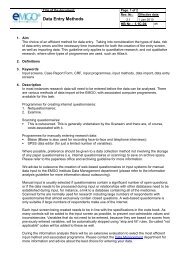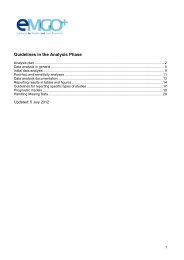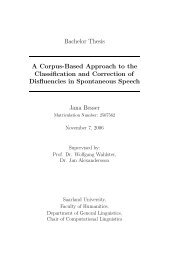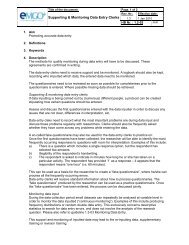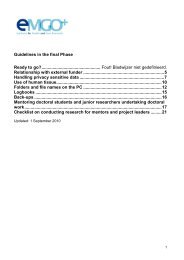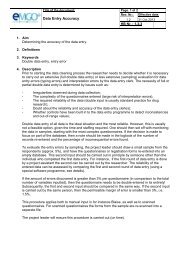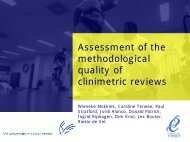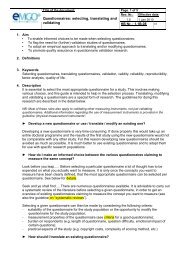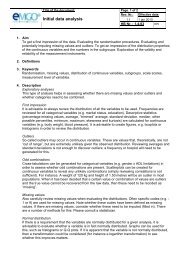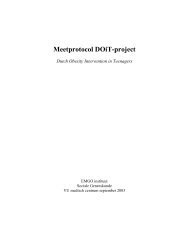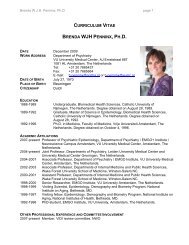Guidelines in the Preparation Phase: Data Collection - EMGO
Guidelines in the Preparation Phase: Data Collection - EMGO
Guidelines in the Preparation Phase: Data Collection - EMGO
You also want an ePaper? Increase the reach of your titles
YUMPU automatically turns print PDFs into web optimized ePapers that Google loves.
<strong>Guidel<strong>in</strong>es</strong> <strong>in</strong> <strong>the</strong> <strong>Preparation</strong> <strong>Phase</strong>: <strong>Data</strong> <strong>Collection</strong>Pilot study........................................................................................................................................... 2Information Analysis ........................................................................................................................... 5Codebook ........................................................................................................................................... 7<strong>Data</strong> Entry Methods...........................................................................................................................12Recruit<strong>in</strong>g and Tra<strong>in</strong><strong>in</strong>g <strong>Data</strong> Collectors.............................................................................................14Recruit<strong>in</strong>g and Tra<strong>in</strong><strong>in</strong>g <strong>Data</strong> Entry Clerks .........................................................................................16Deal<strong>in</strong>g with Study Participants .........................................................................................................17Authorship .........................................................................................................................................19Updated: 28 January 20131
Title of <strong>the</strong> document:Pilot studyPage. 2 of 21Rev. Nr.: Effective date:1.1 1 Jan 2010HB Nr. : 1.1C-01 rdv1. AimThe aim of pilot studies is to explore certa<strong>in</strong> issues before undertak<strong>in</strong>g a large-scale study2. Def<strong>in</strong>itions3. KeywordsPilot study, feasibility,4. DescriptionIntroductionThe aim of pilot studies is to explore certa<strong>in</strong> issues before undertak<strong>in</strong>g a large-scale study (1). Pilotstudies are rarely just a small version of a larger study; <strong>the</strong>y have o<strong>the</strong>r objectives than <strong>the</strong> largescalestudy.Aims of a pilot studyCerta<strong>in</strong> aspects of <strong>the</strong> large-scale study can be tested out <strong>in</strong> a pilot study. This may <strong>in</strong>volve test<strong>in</strong>gfeasibility <strong>in</strong> practice or improv<strong>in</strong>g <strong>the</strong> methodological quality of parts of <strong>the</strong> study. Examples will beprovided for both of <strong>the</strong>se. Occasionally people undertake pilot studies <strong>in</strong> order to obta<strong>in</strong> an estimateof <strong>the</strong> effect size, with <strong>the</strong> notion of whe<strong>the</strong>r it is worth <strong>the</strong> effort to conduct a large-scale study <strong>in</strong> <strong>the</strong>back of <strong>the</strong>ir m<strong>in</strong>ds. Pilot studies are not suitable for this purpose, as will be expla<strong>in</strong>ed below <strong>in</strong> detail.Examples of questions about feasibility• What is <strong>the</strong> anticipated number of patients/participants that can be <strong>in</strong>cluded? Patient <strong>in</strong>clusionusually appears to be much lower than <strong>the</strong> total number of eligible patients, and also much lowerthan <strong>the</strong> numbers doctors (and o<strong>the</strong>r recruiters) promise to deliver. For <strong>in</strong>stance, <strong>in</strong> some recenttrials it appeared that approx. 60% of company doctors (2) and physio<strong>the</strong>rapists (3) who hadpromised to provide patients, had not registered a s<strong>in</strong>gle patient, and approx. 20% of “recruiters”had only recruited a s<strong>in</strong>gle patient.• How many of <strong>the</strong> potential patients satisfy <strong>the</strong> <strong>in</strong>clusion and exclusion criteria? You may considerto relax some of <strong>the</strong> criteria <strong>in</strong> <strong>the</strong> large-scale study.• Will <strong>the</strong> eligible participants agree to be randomised for comparison of <strong>the</strong> <strong>in</strong>terventions? This isespecially important for certa<strong>in</strong> populations, for <strong>in</strong>stance, <strong>the</strong> elderly or (parents of) small childrenor groups where experience from o<strong>the</strong>r studies is lack<strong>in</strong>g.• Why do some participants not want to take part or what are <strong>the</strong> reasons for drop out? You mightbe able to <strong>in</strong>terview <strong>the</strong>se people to understand <strong>the</strong> reasons for non-participation (<strong>the</strong>se mayperhaps be reasons that could be easily overcome <strong>in</strong> <strong>the</strong> large-scale study).• Are all medical files or <strong>in</strong>formation from o<strong>the</strong>r data sources retrievable?• Have all <strong>the</strong> necessary details been registered <strong>in</strong> statuses (doctors are sometimes overly positiveabout this issue), and is <strong>the</strong> quality of <strong>the</strong> data adequate?• Can all measurements be easily implemented and are <strong>the</strong>y not too bo<strong>the</strong>rsome for <strong>the</strong> researchparticipants?• What is <strong>the</strong> best recruitment method? For <strong>in</strong>stance, is it beneficial to <strong>in</strong>volve <strong>the</strong> GP, or would thishave <strong>the</strong> opposite effect?• Is <strong>the</strong> <strong>in</strong>tervention appropriate for <strong>the</strong> <strong>in</strong>tended target group (e.g. language use, type of<strong>in</strong>tervention)?• Is it possible to carry out <strong>the</strong> <strong>in</strong>tervention <strong>in</strong> <strong>the</strong> target group with respect to acceptability andcompliance?• Is it possible to <strong>the</strong> implement <strong>the</strong> <strong>in</strong>tervention and/or study <strong>in</strong> <strong>the</strong> organisation?• How much time does <strong>the</strong> measurement procedure take, and how many times can this beundertaken per day?• What is <strong>the</strong> best way to approach <strong>the</strong> target group?2
Examples of questions about methodological quality• Is it possible to bl<strong>in</strong>d <strong>the</strong> patients for <strong>the</strong> type of <strong>in</strong>tervention?• Are <strong>the</strong> measurement <strong>in</strong>struments valid?• Are <strong>the</strong> measurements reproducible: Are your research assistants perform<strong>in</strong>g <strong>the</strong> measurements<strong>in</strong> exactly <strong>the</strong> same way?• Are <strong>the</strong> questionnaires be<strong>in</strong>g completed properly? Is <strong>the</strong> word<strong>in</strong>g of <strong>the</strong> questions clear andcomprehensible?• What is <strong>the</strong> most efficient measurement method for reproducible measurements (see for <strong>in</strong>stanceObservations: Who, when and how often?)• Is exposure (for <strong>in</strong>stance <strong>in</strong> a cohort study) be<strong>in</strong>g properly measured?Pilot studies are less suitable for estimates of effect sizeThis applies to both efficacy of an <strong>in</strong>tervention, as well as to <strong>the</strong> strength of association <strong>in</strong> anobservational study. The reason for this is that pilot studies are too small to achieve a reliableestimate of <strong>the</strong> effect. In o<strong>the</strong>r words, <strong>the</strong> confidence <strong>in</strong>terval around <strong>the</strong> observed effect size will bevery large, and all values ly<strong>in</strong>g with<strong>in</strong> <strong>the</strong> confidence <strong>in</strong>terval may be potential values of <strong>the</strong> actualeffect size. The effect size determ<strong>in</strong>ed <strong>in</strong> a pilot study is often used to calculate, on <strong>the</strong> basis of <strong>the</strong>confidence <strong>in</strong>terval, <strong>the</strong> number of participants required <strong>in</strong> a large trial <strong>in</strong> order for <strong>the</strong> effect to bestatistically significant. This is not justified. The erroneous assumption here is that <strong>the</strong> effect sizefound represents <strong>the</strong> true effect. Beurskens et al. (1) has presented an illustrative example of howmislead<strong>in</strong>g a pilot study can be. The correct <strong>in</strong>terpretation is that all values <strong>in</strong> <strong>the</strong> confidence <strong>in</strong>tervalcould represent <strong>the</strong> actual effect, mean<strong>in</strong>g that when <strong>the</strong> confidence <strong>in</strong>terval <strong>in</strong>cludes <strong>the</strong> neutralvalue (0 for differences and 1 for ratios), <strong>the</strong> effect could actually be both positive and negative.However, pilot studies can be used to provide an <strong>in</strong>dication of <strong>the</strong> variance <strong>in</strong> measurement, that is,<strong>the</strong> standard deviation which can be used for <strong>the</strong> power calculation for <strong>the</strong> ma<strong>in</strong> study.Organisation: Internal or external pilot studiesExternal pilot:Pilot studies may precede larger studies and may <strong>in</strong>clude a clear go/no go decision. If <strong>the</strong> researchaim/question of <strong>the</strong> pilot study is formulated <strong>in</strong> concrete, measurable terms, <strong>the</strong>n a clear decision canbe taken on <strong>the</strong> basis of <strong>the</strong> results. This decision may be for <strong>in</strong>stance, that clear modifications <strong>in</strong>study design are required or that <strong>the</strong> larger study is not feasible.Internal pilot:If <strong>the</strong> pilot study exactly replicates <strong>the</strong> large study, e.g. a trial, <strong>the</strong>n it may turn out that noth<strong>in</strong>g needsto be altered based on <strong>the</strong> pilot study Therefore, why shouldn’t patients <strong>in</strong> <strong>the</strong> pilot study be <strong>in</strong>cludedas <strong>the</strong> first participants <strong>in</strong> <strong>the</strong> larger study? There is noth<strong>in</strong>g to stop you from do<strong>in</strong>g this. However, youdo need to make sure that <strong>the</strong> decision not to change <strong>the</strong> procedures is made, because one wants toadd <strong>the</strong> patients of <strong>the</strong> pilot study to <strong>the</strong> larger study. It helps if clear agreements have been made <strong>in</strong>advance about this.5. DetailsExampleObservations: Who, when and how often?You want to measure employees’ physical exertion us<strong>in</strong>g a cohort study on “musculoskeletalcompla<strong>in</strong>ts”. The decision is made to create video record<strong>in</strong>gs, which are reviewed at a later stage byresearch assistants scor<strong>in</strong>g certa<strong>in</strong> parameters. A feasibility study (4) can be carried out <strong>in</strong> order tojudge whe<strong>the</strong>r <strong>the</strong>se record<strong>in</strong>gs need to be made and/or scored for all employees (with <strong>the</strong> samerole), or whe<strong>the</strong>r whole work<strong>in</strong>g days (8 hours per day) need to be scored, and for how many days <strong>in</strong><strong>the</strong> week, and whe<strong>the</strong>r <strong>the</strong> research assistants are scor<strong>in</strong>g <strong>in</strong> <strong>the</strong> same way. A study such as this isaimed at f<strong>in</strong>d<strong>in</strong>g <strong>the</strong> most efficient and reliable way of collect<strong>in</strong>g <strong>the</strong> data.All potential variations can be <strong>in</strong>cluded <strong>in</strong> <strong>the</strong> pilot study (e.g. different research assistants, differentdurations, different days, different employees with <strong>the</strong> same role). Subsequently, <strong>the</strong> result<strong>in</strong>gvariance components can be used to determ<strong>in</strong>e <strong>the</strong> most efficient and preferable method to be used<strong>in</strong> <strong>the</strong> larger study. This example can, of course, also be translated to o<strong>the</strong>r situations that <strong>in</strong>cludeobservations: E.g. observations of patients or <strong>the</strong>ir carers, or certa<strong>in</strong> types of child behaviour.3
6. Appendices/references/l<strong>in</strong>ksReferences:Beurskens AJHM, de Vet HCW, IJ Kant. Dwal<strong>in</strong>gen <strong>in</strong> de methodolologie (Methodological errors).VIII. Pilot onderzoeken: z<strong>in</strong> en onz<strong>in</strong>. (Pilot studies: Sense and nonsense). Ned T Geneesk 1998;142: 2142-2145.Steenstra I. Back pa<strong>in</strong> management <strong>in</strong> Dutch occupational health care. Thesis VU Amsterdam 2004(<strong>in</strong> general discussion).Pool J. Neck pa<strong>in</strong>, a pa<strong>in</strong> <strong>in</strong> <strong>the</strong> neck? A study on <strong>the</strong>rapeutic modalities and cl<strong>in</strong>imetrics. Thesis VUAmsterdam 2007 (<strong>in</strong> general discussion).Stre<strong>in</strong>er DL, Norman GR. Health measurements scales. Chapter 9 Generalisability <strong>the</strong>ory. 3rd ed,Oxford University Press, 2003.7. AmendmentsV1.1 1 Jan 2010: Translated <strong>in</strong>to English.V1.0 14 Feb 2007.4
A standard Access database is available for track<strong>in</strong>g <strong>the</strong> data flow dur<strong>in</strong>g a project. Once modified,this database is suitable for many projects and can be used for send<strong>in</strong>g questionnaires, rem<strong>in</strong>ders,etc. The <strong>Data</strong> Management department will configure this database for use <strong>in</strong> your project.ResultsThe most important conclusions follow<strong>in</strong>g <strong>the</strong> <strong>in</strong>formation analysis are:Is an adm<strong>in</strong>istrative system required for monitor<strong>in</strong>g and manag<strong>in</strong>g <strong>the</strong> data flow?What is <strong>the</strong> best way to import data?Who does what? Which activities fall with<strong>in</strong> <strong>the</strong> <strong>Data</strong> Management basic supportpackage, and which chargeable activities can be <strong>in</strong>cluded <strong>in</strong> <strong>the</strong> project?The <strong>in</strong>formation analysis outcomes will be described <strong>in</strong> <strong>the</strong> <strong>in</strong>formation plan. The <strong>in</strong>formation planconsists on <strong>the</strong> one hand of an <strong>in</strong>ventory of <strong>the</strong> data management aspects of <strong>the</strong> research, and on<strong>the</strong> o<strong>the</strong>r of advice regard<strong>in</strong>g <strong>the</strong> best approach. This <strong>in</strong>formation plan is drawn up and archived by<strong>the</strong> D&S department. A copy of <strong>the</strong> plan will be provided to <strong>the</strong> researcher and project leader.Different studies place different demands on data usage: For large cohort studies, such as LASA,AGGO and <strong>the</strong> Hoorn study, <strong>the</strong>re is often a great deal of <strong>in</strong>frastructure and additional datamanagement support already present for carry<strong>in</strong>g out <strong>the</strong> research.5. DetailsAudit questions:Has an early appo<strong>in</strong>tment been made with <strong>the</strong> <strong>Data</strong> Management department or your own datamanager associated with your research group? If not: What are reasons for this? Has <strong>the</strong> advicedescribed <strong>in</strong> <strong>the</strong> <strong>in</strong>formation plan been followed?6. Appendices/references/l<strong>in</strong>ks7. AmendmentsV 1.3: 1 Jan 2010: English translation.V1.2: 27 May 2009: Support from <strong>the</strong> <strong>Data</strong> Management department developed fur<strong>the</strong>r and realisedand need for a paperless office emphasised.V1.1: 19 Okt 2006: Support from D&S described more extensively and updated.6
Title of <strong>the</strong> document:CodebookPage. 7 of 21Rev. Nr.: Effective date:1.2 1 Jan 2010HB Nr. : 1.1C-03 wk1. AimTo clarify what constitutes a good codebook.2. Def<strong>in</strong>itionsCodebook: Description of <strong>the</strong> data as stored on <strong>the</strong> computer.3. KeywordsCodebook, cod<strong>in</strong>g4. DescriptionThe codebook conta<strong>in</strong>s <strong>the</strong> names and descriptions of <strong>the</strong> variables, <strong>the</strong> range of correct values and<strong>in</strong>correct values and cod<strong>in</strong>g for correct and <strong>in</strong>correct miss<strong>in</strong>g values.A codebook is required:To create a data entry systemFor data entryFor statistical analysisWhen archiv<strong>in</strong>g data files once <strong>the</strong> study has been completed to, for <strong>in</strong>stance, enable follow-upstudies.A good codebook consists of columns conta<strong>in</strong><strong>in</strong>g <strong>the</strong> item or <strong>the</strong> description of <strong>the</strong> item along with <strong>the</strong>item number, <strong>the</strong> allocated variable name (consist<strong>in</strong>g of a maximum of 8 characters), <strong>the</strong> variabletype, normally (numeric(N), alphanumeric/str<strong>in</strong>g (A) or a date) and <strong>the</strong> number of characters, <strong>the</strong>potential values <strong>the</strong> variable can take and cod<strong>in</strong>g for <strong>the</strong> values, <strong>in</strong>clud<strong>in</strong>g cod<strong>in</strong>g for(correct/<strong>in</strong>correct) miss<strong>in</strong>g values. A codebook can also be potentially created by typ<strong>in</strong>g variablenames, codes, etc. <strong>in</strong>to an empty list of questions. It is also possible to derive a codebookretrospectively <strong>in</strong> SPSS from an SPSS file by select<strong>in</strong>g <strong>the</strong> Utilities option <strong>in</strong> <strong>the</strong> ma<strong>in</strong> menu, and <strong>the</strong>nselect<strong>in</strong>g File Info.For any data entry method it is necessary for <strong>the</strong> researcher to create a codebook <strong>in</strong> advance. Thisalso applies if <strong>the</strong> data entry and/or creation of <strong>the</strong> entry screen or questionnaire scann<strong>in</strong>g have beenoutsourced. When creat<strong>in</strong>g a codebook, a transcription takes places from <strong>the</strong> questionnaire to <strong>the</strong>variables. The questions are coded and this <strong>in</strong>cludes <strong>the</strong> allocation of values for miss<strong>in</strong>g observations(miss<strong>in</strong>g values). The aim is to create a separate codebook for each questionnaire. An entry screencan be created <strong>in</strong> BLAISE, MS-Access, Netquestionaires / Elisten or Teleform us<strong>in</strong>g <strong>the</strong> codebook.The codebook allows <strong>the</strong> <strong>in</strong>dividuals enter<strong>in</strong>g <strong>the</strong> data to understand how encoded items should beentered. Fur<strong>the</strong>rmore, a codebook is a necessity for statistical analysis us<strong>in</strong>g, for <strong>in</strong>stance, SPSS.Variables are referred to by a variable name of a maximum 8 characters <strong>in</strong> virtually all statisticalprogrammes. These variable names often obscure <strong>the</strong> actual mean<strong>in</strong>g of <strong>the</strong> variable. Refer to <strong>the</strong>details for advice on cod<strong>in</strong>g variables.7
5. DetailsNam<strong>in</strong>g variablesTry to provide mean<strong>in</strong>gful names for <strong>the</strong> variables that say someth<strong>in</strong>g about <strong>the</strong> nature of <strong>the</strong> item.Avoid cryptic descriptions. One suggestion is to always use <strong>the</strong> first letter(s) of <strong>the</strong> relevant form for<strong>the</strong> start of <strong>the</strong> variable name. Use capitals for <strong>the</strong> variable names for clarity. Use specific symbolswith care. For <strong>in</strong>stance, variable names cannot start with a number <strong>in</strong> SPSS. Make sure that avariable name is never longer than 8 characters, even though variable names may be longer than 8characters with<strong>in</strong> <strong>the</strong> associated database programme. Avoid us<strong>in</strong>g spaces <strong>in</strong> variable names. Themajority of statistical packages are only able to handle variable names that are no longer than 8characters. When convert<strong>in</strong>g a 10-character name from Access, for <strong>in</strong>stance, <strong>the</strong>re may be a risk that<strong>the</strong> variable name is no longer unique <strong>in</strong> SPSS.For <strong>in</strong>stance:Access variable namePYNSCORE10PYNSCORE20Result<strong>in</strong>g SPSS variable namePYNSCORPYNSCOREExampleVAR. NAMECINCLUDEIORIGINFREGSYMP1SOCIALQUESTION ON FORMFormulate a “card <strong>in</strong>dex search”, <strong>in</strong> which a specific<strong>in</strong>clusion criterion is completedFormulate “<strong>in</strong>clusion consultation”, <strong>in</strong> which ethnic orig<strong>in</strong> iscompletedFormulate “follow-up consultation”, <strong>in</strong> which occurrence ofregular symptoms is documentedPatient questionnaire time po<strong>in</strong>t 1, <strong>in</strong> which effect of illnesson social life is exploredIf <strong>the</strong> same questions occur at different time po<strong>in</strong>ts, this needs to be <strong>in</strong>dicated clearly <strong>in</strong> <strong>the</strong> variablenames by <strong>in</strong>clud<strong>in</strong>g <strong>the</strong> relevant time po<strong>in</strong>t <strong>in</strong> <strong>the</strong> name. For <strong>in</strong>stance: P1PAIN, P2PAIN, P3PAIN, (<strong>the</strong>participant is asked about pa<strong>in</strong> at 3 time po<strong>in</strong>ts). This does not, of course, apply to variables withunique values allow<strong>in</strong>g files to be l<strong>in</strong>ked toge<strong>the</strong>r, such as patient numbers, etc. These variablesshould always have <strong>the</strong> same name for each time po<strong>in</strong>t and form, for <strong>in</strong>stance, PATNO.The f<strong>in</strong>d and replace function <strong>in</strong> Word can be used to reduce <strong>the</strong> amount of time needed to createcodebooks for different time po<strong>in</strong>ts.Questions allow<strong>in</strong>g more than one answerMultiple choice questions allow<strong>in</strong>g multiple answers need to be split up <strong>in</strong> <strong>the</strong> codebook <strong>in</strong>to as manyvariables as <strong>the</strong>re are response categories. The values for <strong>the</strong>se variables may be ei<strong>the</strong>r 1 or 0, ifselected or not selected, respectively. Miss<strong>in</strong>g values are not possible for this type of question, as it isimpossible to dist<strong>in</strong>guish between “response categories missed” and “response category notendorsed". If <strong>the</strong> item conta<strong>in</strong>s a conditional question, that is, where <strong>the</strong> response is dependent on<strong>the</strong> answer to a previous question, <strong>the</strong>n <strong>the</strong> "not applicable value" is also potentially possible.8
Two types of miss<strong>in</strong>g valuesA miss<strong>in</strong>g value result<strong>in</strong>g from an erroneously miss<strong>in</strong>g detail (omission or refusal to answer <strong>the</strong>question, etc) is usually coded with highest possible out-of-range value. For <strong>in</strong>stance, for a multiplechoice question with response categories 1 to 5, this would be value 9.For a date variable it is best to use a date from <strong>the</strong> distant past as a value for <strong>the</strong> <strong>in</strong>correct miss<strong>in</strong>gvalue (usually <strong>the</strong> date 14-12-1985 is used for this – <strong>the</strong> Blaise <strong>in</strong>put programme does thisautomatically).If <strong>the</strong> miss<strong>in</strong>g value results from a correct miss<strong>in</strong>g detail (i.e. <strong>the</strong> question is not applicable), <strong>the</strong>n <strong>the</strong>variable is left blank. In SPSS this will be automatically coded as system miss<strong>in</strong>g (a dot). Thesevalues are usually filled <strong>in</strong> automatically <strong>in</strong> <strong>the</strong> data entry programme where <strong>the</strong> not applicablequestion has been omitted. Particularly <strong>in</strong> older files a value o<strong>the</strong>r than may be entered for acorrect miss<strong>in</strong>g value, for <strong>in</strong>stance, 8 or 88, etc.As alphanumeric variables are not handled by statistical programmes, no dist<strong>in</strong>ction is made betweencorrect or erroneous miss<strong>in</strong>g alphanumeric values. In both <strong>in</strong>stances <strong>the</strong> cell is simply left empty.Audit questions: Is <strong>the</strong>re a codebook? If not, why not?If yes, would ano<strong>the</strong>r researcher not associated with <strong>the</strong> project be able to understand it and is <strong>the</strong>codebook up-to-date?9
QuestionVariablenameType Value CodeCompulsory1. Patient numberPATNO N 3 001-998 001-998 Yes &unique2. GP code GPCODE N 1 1-9miss<strong>in</strong>g3. Sec SEX N 1MaleFemaleMiss<strong>in</strong>g4. Date of birth DOB datum 01/01/1940-01/01/1980miss<strong>in</strong>g1-99912901/01/1940-01/01/198014/12/1985yesyesno5. Number of pregnancies PREGNANT N 1 0-8miss<strong>in</strong>gna (sex=1)6. Illness <strong>in</strong> family FAMILL N 1 yesnomiss<strong>in</strong>g0-89empty129noyes7. Which family illnesses- Diabetes DIABETES N 1 selectednot selected- Respiratory RESP N 1 selectednot selected10 no10 no- Cardiovascular CARDIOV N 1 selectednot selected- O<strong>the</strong>r illnesses OTHILL N 1 selectednot selected7a. Which o<strong>the</strong>r illnesses WHICHILL A 30miss<strong>in</strong>gna (othill=0)8. Weight <strong>in</strong> Kg WEIGHT N 3 45-140miss<strong>in</strong>g9. Height <strong>in</strong> metres HEIGHT N 1.2 1,20-2,25miss<strong>in</strong>g10 nee10 noleegleegno45-140999 yes1,20-2,259,99 yes10. Last job JOB A 50 noAn example can be found <strong>in</strong> <strong>the</strong> quality assurance handbook with this guidel<strong>in</strong>e.6. Appendices/references/l<strong>in</strong>ksStandard codebookThe Introductory Meet<strong>in</strong>g <strong>Data</strong> Management part1, which is compulsory for doctoral students,discusses codebooks <strong>in</strong> more detail.7. AmendmentsV1.2: 1 Jan 2010: English translation.V1.1: 19 October 2006: Updated and m<strong>in</strong>or textual amendments.11
Dur<strong>in</strong>g <strong>the</strong> <strong>in</strong>formation analysis <strong>the</strong>re will be an extensive evaluation to select <strong>the</strong> most efficient <strong>in</strong>putmethod and associated programme. Please contact <strong>the</strong> <strong>Data</strong> Management department for more<strong>in</strong>formation and advice about <strong>the</strong> best choice for enter<strong>in</strong>g your data.5. DetailsAudit questions1. Has <strong>the</strong> most efficient method been selected, given <strong>the</strong> research population and nature of <strong>the</strong>data?2. Has a standard <strong>EMGO</strong> programme been used for <strong>the</strong> data <strong>in</strong>put? If not, why not?3. Have efficient <strong>in</strong>put screens been used for <strong>the</strong> data <strong>in</strong>put? That is, have <strong>the</strong> data been stored<strong>in</strong> <strong>the</strong> underly<strong>in</strong>g database <strong>in</strong> l<strong>in</strong>e with <strong>the</strong> specifications <strong>in</strong> <strong>the</strong> code book?6. Appendices/references/l<strong>in</strong>ksIntroductory Meet<strong>in</strong>g <strong>Data</strong> Management part 1. This document expla<strong>in</strong>s <strong>in</strong> detail <strong>the</strong> criteria to beemployed when decid<strong>in</strong>g to use a particular system, and <strong>the</strong> criteria on which you decide to do thisyourself or to outsource <strong>the</strong> process. The pr<strong>in</strong>ciples of a good data entry screen are also expla<strong>in</strong>ed <strong>in</strong>this document.7. AmendmentsV2.1: 1 Jan 2010: English translation.V2.0: 27 May 2009: Updated based on current standards and processes.V1.1: 19 Oct 2006: Update.13
Title of <strong>the</strong> document:Page. 14 of 21Rev. Nr.: Effective date:Recruit<strong>in</strong>g and Tra<strong>in</strong><strong>in</strong>g <strong>Data</strong>1.3 1 Jan 2010Collectors HB Nr. : 1.1C-05 mvh1. Aim- Recruit<strong>in</strong>g well-qualified data collectors- To standardise data collection as best as possible2. Def<strong>in</strong>itions3. KeywordsQualification, standardisation, tra<strong>in</strong><strong>in</strong>g, protocol, data collector, assistant, student4. DescriptionA good data collector for scientific research needs to have a number of specific qualities that can beused as selection criteria when recruit<strong>in</strong>g. The qualities required may, of course, differ from study tostudy. It is good practice to create a list of qualifications <strong>in</strong> advance detail<strong>in</strong>g <strong>the</strong> aspects <strong>the</strong> datacollector(s) need(s) to be able to fulfil for your study (see examples <strong>in</strong> details).The data collectors need to be given sufficient background knowledge about <strong>the</strong> study. They need toknow how and why certa<strong>in</strong> details are be<strong>in</strong>g collected (<strong>the</strong> ultimate aim or <strong>the</strong> specific <strong>in</strong>formation <strong>the</strong>test/questionnaire will provide). This knowledge can be acquired through a protocol and tra<strong>in</strong><strong>in</strong>g(where required).The necessary background <strong>in</strong>formation needs to be established <strong>in</strong> a comprehensive data collectionprotocol, <strong>in</strong>clud<strong>in</strong>g a description of all <strong>the</strong> measurement/<strong>in</strong>terview components. The data collectorsneed to be aware of this protocol.For many studies it is important that <strong>the</strong> data are collected <strong>in</strong> an as standardised way as possible.This means that <strong>the</strong> <strong>in</strong>terviews or test schedules need to be standardised. The data collector needs toconduct <strong>the</strong> <strong>in</strong>terview or present <strong>the</strong> test <strong>in</strong> exactly <strong>the</strong> same way each time (as little as possible <strong>in</strong>traobservervariation). Comprehensive <strong>in</strong>structions and <strong>in</strong>terview or test tra<strong>in</strong><strong>in</strong>g will be required for this.Where <strong>the</strong>re are multiple data collectors, mutual differences will need to be measured andm<strong>in</strong>imalised (as little as possible <strong>in</strong>ter-observer variation). Comprehensive tra<strong>in</strong><strong>in</strong>g will also berequired for this.To tra<strong>in</strong> <strong>the</strong> data collectors properly, it is important to create a tra<strong>in</strong><strong>in</strong>g protocol before <strong>the</strong> start of <strong>the</strong>study. This protocol will <strong>in</strong>clude: <strong>the</strong> <strong>in</strong>structions to be provided, who is conduct<strong>in</strong>g <strong>the</strong> tra<strong>in</strong><strong>in</strong>g andwhe<strong>the</strong>r <strong>the</strong> tra<strong>in</strong><strong>in</strong>g will be repeated dur<strong>in</strong>g <strong>the</strong> data collection. It is also important to <strong>in</strong>dicate at whatstage <strong>the</strong> data collectors will have received sufficient tra<strong>in</strong><strong>in</strong>g. Fixed guidel<strong>in</strong>es can be drawn up forthis by sett<strong>in</strong>g a specific threshold (for <strong>in</strong>stance Cohen’s Kappa > 0.6 for <strong>in</strong>ter-observer variation), or<strong>the</strong> requirement that <strong>the</strong> data collector meets <strong>the</strong> same level of measurements/observations as a goldstandard or highly experienced data collector. If <strong>the</strong>re are multiple data collectors active with<strong>in</strong> <strong>the</strong>study, <strong>the</strong> <strong>in</strong>ter-observer variation needs to be measured and m<strong>in</strong>imalised through tra<strong>in</strong><strong>in</strong>g.New data collectors, start<strong>in</strong>g dur<strong>in</strong>g <strong>the</strong> data collection process, should be tra<strong>in</strong>ed by <strong>the</strong> same<strong>in</strong>dividuals who provided <strong>the</strong> orig<strong>in</strong>al tra<strong>in</strong><strong>in</strong>g, and not by o<strong>the</strong>r data collectors.N.b.: In some cases it may be necessary for measurements to be generalisable to daily practice (e.g.effects of usual care). In this event comprehensive tra<strong>in</strong><strong>in</strong>g will be undesirable.14
5. DetailsA number of examples of qualification requirements for <strong>the</strong> data collectors are summarised below.These can be used when recruit<strong>in</strong>g staff:• Tra<strong>in</strong>able for conduct<strong>in</strong>g <strong>in</strong>terviews/tests;• Experience or aff<strong>in</strong>ity with participant;• Knowledge of, or experience with <strong>the</strong> research topic;• Experience work<strong>in</strong>g with GP’s, doctors, specialists, etc.;• Experience us<strong>in</strong>g data files;• Experience us<strong>in</strong>g specific computer programmes;• Able to undertake simple adm<strong>in</strong>istrative tasks;• Able to work with high levels of accuracy;• Able to work <strong>in</strong>dependently;• Have good communication skills;• Presentable;• Flexible;• Available for <strong>the</strong> whole study period;• Own car.Experience <strong>in</strong> data collection might sometimes be helpful, and sometimes be unhelpful. Frommethodological literature about surveys it is known that data collectors’ experience is negativelyassociated with data quality. An explanation for this is <strong>the</strong> fact that people develop <strong>the</strong>ir own style <strong>in</strong>order to obta<strong>in</strong> an answer quickly and efficiently (<strong>the</strong>y may prompt a response, or make suggestions,or just jot someth<strong>in</strong>g down as <strong>the</strong>y know that item non-response is not preferred, etc., etc.). They alsoappear to be less tra<strong>in</strong>able for new studies. In large American surveys <strong>in</strong>terviewers are sometimesreplaced after 50 <strong>in</strong>terviews <strong>in</strong> order to randomise background noise.Some of practical tips about recruit<strong>in</strong>g research assistants can be found here.5. Audit questions1) Has a qualification list been created for recruit<strong>in</strong>g <strong>the</strong> data collectors?Have <strong>the</strong> data collectors been <strong>in</strong>formed of <strong>the</strong> aim of <strong>the</strong> study and <strong>the</strong> tests/questionnaires?2) Have all <strong>the</strong> measurement/<strong>in</strong>terview components been established <strong>in</strong> a protocol?3) Has a tra<strong>in</strong><strong>in</strong>g protocol been established for <strong>the</strong> study?4) Have <strong>the</strong> data collectors been tra<strong>in</strong>ed? If so, how and by whom?5) Are multiple data collectors <strong>in</strong>volved <strong>in</strong> <strong>the</strong> study? If so, which measures have been taken tomeasure and reduce mutual variation?6) Have new data collectors been recruited dur<strong>in</strong>g <strong>the</strong> data collection process? If so, who tra<strong>in</strong>ed<strong>the</strong>se data collectors? Which measures have been taken to measure and reduce mutual variationbetween <strong>the</strong> new data collectors?6. Appendices/references/l<strong>in</strong>ks7. AmendmentsV1.3 1 Jan 2010: Translation <strong>in</strong>to English.V1.2: July 8, 2008: M<strong>in</strong>or textual modifications.V1.1: October 19, 2006: Reference to <strong>the</strong> quality handbook.15
Title of <strong>the</strong> document:Recruit<strong>in</strong>g and Tra<strong>in</strong><strong>in</strong>g <strong>Data</strong> EntryPage. 16 of 21Rev. Nr.: Effective date:1.1 1 Jan 2010Clerks HB Nr. : 1.1C-06 mvh1. Aim Promot<strong>in</strong>g accurate data entry2. Def<strong>in</strong>itions3. Keywords4. DescriptionDespite <strong>the</strong> fact that <strong>the</strong> fields to be entered can be def<strong>in</strong>ed with<strong>in</strong> modern data entry programmes, itis important that <strong>the</strong> data are entered <strong>in</strong> as standardised a way as possible. Conscious data entry canrapidly switch over onto automatic pilot. Therefore it is important that <strong>the</strong> data entry clerk(s)cont<strong>in</strong>ue(s) to work <strong>in</strong> <strong>the</strong> same way. To motivate <strong>the</strong> clerks and let <strong>the</strong>m understand <strong>the</strong> importanceof accurate data entry, it is necessary to provide <strong>the</strong>m with extensive background <strong>in</strong>formation about<strong>the</strong> data entry screens and <strong>the</strong> questionnaires to be entered.If <strong>the</strong>re are multiple data entry clerks, <strong>the</strong> mutual differences need to be m<strong>in</strong>imalised. This can beachieved through tra<strong>in</strong><strong>in</strong>g and mutual co-ord<strong>in</strong>ation between tasks.Repeated measurements over time should be processed by <strong>the</strong> same person as much as possible.When new data entry clerks are recruited dur<strong>in</strong>g <strong>the</strong> data collection process, it is preferable for <strong>the</strong>se<strong>in</strong>dividuals to be tra<strong>in</strong>ed by <strong>the</strong> same person who provided <strong>the</strong> orig<strong>in</strong>al tra<strong>in</strong><strong>in</strong>g. New data entry clerkscan also be tra<strong>in</strong>ed by a good data entry clerk, provided that <strong>the</strong> orig<strong>in</strong>al tra<strong>in</strong>er is present dur<strong>in</strong>g<strong>the</strong>se sessions. This to allow <strong>the</strong> tra<strong>in</strong>er to monitor whe<strong>the</strong>r <strong>the</strong> <strong>in</strong>put process still corresponds with<strong>the</strong> orig<strong>in</strong>al, approved practice.5. DetailsA good data entry clerk for scientific research needs to have a number of specific qualities. These canbe used as selection criteria when recruit<strong>in</strong>g. The summary below can be viewed as a start<strong>in</strong>g po<strong>in</strong>t:• Experience us<strong>in</strong>g data files;• Experience us<strong>in</strong>g specific computer programmes;• Experience of data collection <strong>in</strong> scientific research;• Able to undertake simple adm<strong>in</strong>istrative tasks;• Able to work accurately;• Asks for help on time when th<strong>in</strong>gs aren‘t clear or when problems occur;• Works <strong>in</strong>dependently;• Has knowledge of, or experience with <strong>the</strong> research topic;Audit questions• Have all data entry clerks received extensive <strong>in</strong>formation? (If so, how and by whom? If not, whynot?)• Are multiple data entry clerks <strong>in</strong>volved <strong>in</strong> <strong>the</strong> study? (If so, which measures have been taken toreduce mutual variation?)• Are <strong>the</strong>re repeated measurements? (If so, will <strong>the</strong>se measurements be processed by <strong>the</strong> samedata entry clerk?)• Have new data entry clerks been recruited dur<strong>in</strong>g <strong>the</strong> project? (If so, who tra<strong>in</strong>ed <strong>the</strong>se clerks?)6. Appendices/references/l<strong>in</strong>ks7. AmendmentsV1.1: 1 Jan 2010: English translation.V1.0: 21 April 2004.16
Title of <strong>the</strong> document:Deal<strong>in</strong>g with Study ParticipantsPage. 17 of 21Rev. Nr.: Effective date:1.1 1 Jan 2010HB Nr. : 1.1C-07 mp1. AimEnsur<strong>in</strong>g study participants are treated properly2. Def<strong>in</strong>itions3. KeywordsTrial participants, patients, behaviour, treat<strong>in</strong>g, code of conduct, physical exam<strong>in</strong>ation4. DescriptionGeneralRespect for <strong>in</strong>dividuals tak<strong>in</strong>g part <strong>in</strong> studies is not just limited to observ<strong>in</strong>g regulations or procedures.Researchers and research assistants should be open towards, and feel responsible for <strong>the</strong> needs ofstudy participants. The researcher should approach participants with general courtesy and respect.Try to put yourself <strong>in</strong> <strong>the</strong> participant’s shoes and try to th<strong>in</strong>k what <strong>the</strong> participant would f<strong>in</strong>dunpleasant. Certa<strong>in</strong> measurements can be uncomfortable or burdensome, such as physical orcognitive tests, or an <strong>in</strong>terview about a sensitive topic.The researcher needs to ensure <strong>the</strong>re is a relaxed atmosphere, <strong>in</strong> which <strong>the</strong> participants are alwaysaware <strong>the</strong>y can stop participat<strong>in</strong>g should <strong>the</strong>y wish to do so.InformationThe researcher should provide concrete <strong>in</strong>formation prior to/dur<strong>in</strong>g recruitment, <strong>in</strong>clud<strong>in</strong>g what exactlyis expected from participants, what <strong>the</strong>y have to do, whe<strong>the</strong>r <strong>the</strong>y can leave immediately after a testor whe<strong>the</strong>r <strong>the</strong>y need to recover with a cup of coffee or tea, etc. These issues should be addressed <strong>in</strong>an <strong>in</strong>formation brochure or participants' letter. This <strong>in</strong>formation should also be provided just prior to<strong>the</strong> measurements.The <strong>in</strong>formation provided may <strong>in</strong>clude timel<strong>in</strong>es for responses, for <strong>in</strong>stance that you will contact <strong>the</strong>mafter x weeks, or send a newsletter or (<strong>in</strong>terim) report. The participant should be contacted if <strong>the</strong>setimel<strong>in</strong>es aren’t go<strong>in</strong>g to be achieved.Physical exam<strong>in</strong>ationThe level of undress<strong>in</strong>g needs to be explicitly described <strong>in</strong> <strong>the</strong> <strong>in</strong>formation brochure. The researcherneeds to ensure that <strong>the</strong> study participant’s privacy is optimally safeguarded, by ensur<strong>in</strong>g, amongsto<strong>the</strong>r th<strong>in</strong>gs, adequate study rooms with screens (if required). It is preferable for <strong>the</strong> physicalexam<strong>in</strong>ation to be carried out by staff that is of <strong>the</strong> same sex as <strong>the</strong> research participant. If this cannotbe guaranteed <strong>in</strong> advance, it will need to be clearly stated.Researchers may only conduct physical exam<strong>in</strong>ations if <strong>the</strong>y are sufficiently skilled and authorised todo so.You also need to carefully consider <strong>the</strong> order <strong>in</strong> which <strong>the</strong> physical measurements are carried out. Donot leave people stand<strong>in</strong>g <strong>in</strong> <strong>the</strong>ir underwear for long periods of time; take <strong>the</strong> measurements andallow <strong>the</strong>m to get dressed aga<strong>in</strong>.If a participant <strong>in</strong>dicates (verbally or non-verbally) that he/she havs a problem with a specific part of<strong>the</strong> study, a researcher should respect this, and look for a solution along with <strong>the</strong> participant.Cognitive testsCognitive tests can be tax<strong>in</strong>g/tir<strong>in</strong>g, particularly for old(er) participants. Often <strong>the</strong>re are both short andfull versions of tests. Present participants with <strong>the</strong> short version first; if <strong>the</strong>y score well on this, <strong>the</strong>ncont<strong>in</strong>u<strong>in</strong>g with a more burdensome test will probably not be necessary. A pilot study can be veryuseful to test what <strong>the</strong> best approach to this is.17
In-depth <strong>in</strong>terviewsIt is not always possible to properly estimate <strong>in</strong> advance how tax<strong>in</strong>g an <strong>in</strong>terview will be for aparticipant. An <strong>in</strong>terview may, for <strong>in</strong>stance, be tax<strong>in</strong>g for <strong>the</strong> elderly or for sick participants, or if <strong>the</strong><strong>in</strong>terview covers a sensitive topic, such as euthanasia or screen<strong>in</strong>g for genetic disorders. Indicatebefore <strong>the</strong> <strong>in</strong>terview starts that <strong>the</strong> participant does not have to answer <strong>the</strong> question if he/she doesn’twant to, and also <strong>in</strong>dicate clearly <strong>in</strong> advance precisely what will happen to <strong>the</strong> <strong>in</strong>terview and howconfidentiality will be ma<strong>in</strong>ta<strong>in</strong>ed. If <strong>the</strong> <strong>in</strong>terview appears to be too <strong>in</strong>tensive for someone, you cansuggest that <strong>the</strong> <strong>in</strong>terview is broken up across multiple time po<strong>in</strong>ts.Compla<strong>in</strong>tsIf a study participant has a compla<strong>in</strong>t about <strong>the</strong> study, <strong>the</strong> researcher should pass on <strong>the</strong> compla<strong>in</strong>timmediately to <strong>the</strong> project leader. The project leader should <strong>in</strong>form <strong>the</strong> relevant professor and worktoge<strong>the</strong>r with <strong>the</strong> researcher towards solv<strong>in</strong>g <strong>the</strong> compla<strong>in</strong>t. If a solution cannot be found through thisprocess <strong>the</strong>n <strong>the</strong> Compla<strong>in</strong>ts Committee of <strong>the</strong> VUmc should be contacted. The Medical Affairs Office(bureau medische zaken) should be contacted for any <strong>in</strong>surance claims. Also look at <strong>the</strong> Law andRegulations guidel<strong>in</strong>e (1.1A-01).5. Details6. Appendices/references/l<strong>in</strong>ks7. AmendmentsV1.1: 1 Jan 2010: English translation.V1.0: 19 Oct 2006.18
Title of <strong>the</strong> document:AuthorshipPage. 19 of 21Rev. Nr.: Effective date:1.0 28-1-2013HB Nr. : 1.1C-08 mp1. Aim Stimulate good authorship practice2. Def<strong>in</strong>itions. See page 23. Keywords4. DescriptionIn order to avoid discussions and problems with regard to authorship issues, it is wise to starta discussion about authorship when plann<strong>in</strong>g <strong>the</strong> research and to cont<strong>in</strong>ue to discuss thisissue as <strong>the</strong> project evolves and to keep a written record on your decisions with regard toauthorship. Prevent<strong>in</strong>g a problem is much better than solv<strong>in</strong>g it.Although <strong>in</strong> <strong>the</strong>ory authorship seems ra<strong>the</strong>r straightforward, <strong>in</strong> practice it might often createtensions and discussions. Some common problems relate to nam<strong>in</strong>g people <strong>in</strong> <strong>the</strong> byl<strong>in</strong>e thatcontributed only little or not to <strong>the</strong> research (i.e. gift authorship) or remov<strong>in</strong>g <strong>in</strong>dividuals thatcontributed to <strong>the</strong> research (i.e. ghost authorship). Discussions might arise about whe<strong>the</strong>rsomeone’s contribution was substantial or not. Consultation of authorship guidel<strong>in</strong>es andevidence (such as laboratory logbooks or emails) as well as discussion with junior and seniorcolleagues might help elucidate <strong>the</strong> discussion. Unethical authorship, however, constitutesscientific misconduct. (See Scientific misconduct and Calamities).The International Committee of Medical Journal Editors has recommended <strong>the</strong> follow<strong>in</strong>gcriteria for authorship:• “Authorship credit should be based on 1) substantial contributions to conception anddesign, acquisition of data, or analysis and <strong>in</strong>terpretation of data; 2) draft<strong>in</strong>g <strong>the</strong> article orrevis<strong>in</strong>g it critically for important <strong>in</strong>tellectual content; and 3) f<strong>in</strong>al approval of <strong>the</strong> version tobe published. Authors should meet conditions 1, 2, and 3.• When a large, multicenter group has conducted <strong>the</strong> work, <strong>the</strong> group should identify <strong>the</strong><strong>in</strong>dividuals who accept direct responsibility for <strong>the</strong> manuscript (3). These <strong>in</strong>dividuals shouldfully meet <strong>the</strong> criteria for authorship/contributorship def<strong>in</strong>ed above, and editors will ask<strong>the</strong>se <strong>in</strong>dividuals to complete journal-specific author and conflict-of-<strong>in</strong>terest disclosureforms. When submitt<strong>in</strong>g a manuscript authored by a group, <strong>the</strong> correspond<strong>in</strong>g authorshould clearly <strong>in</strong>dicate <strong>the</strong> preferred citation and identify all <strong>in</strong>dividual authors as well as<strong>the</strong> group name. Journals generally list o<strong>the</strong>r members of <strong>the</strong> group <strong>in</strong> <strong>the</strong>Acknowledgments. The NLM <strong>in</strong>dexes <strong>the</strong> group name and <strong>the</strong> names of <strong>in</strong>dividuals <strong>the</strong>group has identified as be<strong>in</strong>g directly responsible for <strong>the</strong> manuscript; it also lists <strong>the</strong> namesof collaborators if <strong>the</strong>y are listed <strong>in</strong> Acknowledgments.• Acquisition of fund<strong>in</strong>g, collection of data, or general supervision of <strong>the</strong> research groupalone does not constitute authorship.• All persons designated as authors should qualify for authorship, and all those who qualifyshould be listed.• Each author should have participated sufficiently <strong>in</strong> <strong>the</strong> work to take public responsibilityfor appropriate portions of <strong>the</strong> content.• All contributors who do not meet <strong>the</strong> criteria for authorship should be listed <strong>in</strong> anacknowledgments section. Examples of those who might be acknowledged <strong>in</strong>clude aperson who provided purely technical help, writ<strong>in</strong>g assistance, or a departmentchairperson who provided only general support. Editors should ask correspond<strong>in</strong>g authorsto declare whe<strong>the</strong>r <strong>the</strong>y had assistance with study design, data collection, data analysis, ormanuscript preparation. If such assistance was available, <strong>the</strong> authors should disclose <strong>the</strong>identity of <strong>the</strong> <strong>in</strong>dividuals who provided this assistance and <strong>the</strong> entity that supported it <strong>in</strong><strong>the</strong> published article. F<strong>in</strong>ancial and material support should also be acknowledged.”19
The consent of each author with <strong>the</strong> f<strong>in</strong>al version of <strong>the</strong> article is an o<strong>the</strong>r important issue. In<strong>the</strong> light of <strong>the</strong> fraud cases <strong>in</strong> 2012 it is clear that all co-authors can be hold responsible for <strong>the</strong>article Each author must have seen and agreed with <strong>the</strong> f<strong>in</strong>al version before submitt<strong>in</strong>g. Sodon’t forget to add this step <strong>in</strong> your plann<strong>in</strong>g.5. DetailsPublications are first of all a way to communicate communicat<strong>in</strong>g scientific <strong>in</strong>formation tocolleagues. However, <strong>the</strong>y have also become a proof of academic competence. As such <strong>the</strong>yhave become a measurement <strong>in</strong> academic performance and way to compare researchers andresearch <strong>in</strong>stitutes. Consequently, <strong>the</strong>y are used as criteria <strong>in</strong> evaluation for academic promotion,project proposals and <strong>in</strong>ternal and external allocation of funds. ‘Publish or perish’ has become amantra <strong>in</strong> <strong>the</strong> academic world.Publication patters have changes over time. While s<strong>in</strong>gle-author articles were <strong>the</strong> norm a fewdecades ago, <strong>the</strong> average number of authors on scientific manuscripts has drastically <strong>in</strong>creased<strong>in</strong> all fields of science. (1;2) This can be partially expla<strong>in</strong>ed by <strong>the</strong> fact that modern scientificresearch has become <strong>in</strong>creas<strong>in</strong>gly complex and expensive, and requires a multidiscipl<strong>in</strong>ary andmulti-centred research team. As <strong>the</strong> number of persons <strong>in</strong>volved <strong>in</strong> a research project <strong>in</strong>creases, itis normal that <strong>the</strong> number of persons want<strong>in</strong>g acknowledgement and credit for <strong>the</strong>ir work <strong>in</strong>publications grows.The dark side of this author proliferation is that numerous articles name authors who do not meetappropriate authorship criteria. (3;4) Various extreme examples also raised discussions about <strong>the</strong>criteria for authorship. For example, an article listed 972 authors <strong>in</strong> a two pages appendix. (5) Astudy was able to identify 20 researchers worldwide who have published an article every 11,3days dur<strong>in</strong>g a period of 10 years. (6) A case was also describe where researchers <strong>in</strong>itiated ahunger strike aga<strong>in</strong>st <strong>the</strong>ir laboratory director because he wanted to be a coauthor on all <strong>the</strong>publications that were issues <strong>in</strong> his department. (7) The Committee on Publication Ethics(http://publicationethics.org/category/keywords/authorship) describes various cases <strong>in</strong> whichauthorship is be<strong>in</strong>g discussed.These key concepts are copied from:Albert T, Wager E. How to handle authorship disputes: a guide for new researchers.http://publicationethics.org/files/2003pdf12.pdf Accessed 8 March 2012Acknowledgements: Most journals permit (or even encourage) acknowledgement of contributions to aresearch project that do not merit authorship.The ICMJE guidel<strong>in</strong>es state: ‘All o<strong>the</strong>rs who contributed to <strong>the</strong>work who are not authors should be named <strong>in</strong> <strong>the</strong> Acknowledgments, and what <strong>the</strong>y did should bedescribed’. All those who are listed <strong>in</strong> this way should be aware of it. Some journals (ma<strong>in</strong>ly <strong>in</strong> <strong>the</strong> US) willrequire signatures of those acknowledged.Appeals: You may ask a journal to withdraw your name from a paper if it has been <strong>in</strong>cluded aga<strong>in</strong>st yourwishes. However most editors are reluctant to get <strong>in</strong>volved <strong>in</strong> disputes about omitted authors s<strong>in</strong>ce <strong>the</strong>y donot have enough <strong>in</strong>formation to judge such cases. Some journals have an ombudsman, but <strong>the</strong>y deal withcases of alleged misconduct by <strong>the</strong> journal. Similarly, COPE only hears cases submitted by journal editorsand is not an appeal body for cases of disputed authorship.Contributorship: The ICMJE guidel<strong>in</strong>es now recommend that authors should state <strong>the</strong>ir contribution to <strong>the</strong>project: ‘authors should provide a description of what each contributed, and editors should publish that<strong>in</strong>formation’. Some journals publish this <strong>in</strong>formation but <strong>in</strong> most cases it is for <strong>the</strong> benefit of <strong>the</strong> editor, whowants reassurance that <strong>the</strong> criteria have been fulfilled. (See Instructions to Authors.)Correspond<strong>in</strong>g author: The person who receives <strong>the</strong> reviewers’ comments, <strong>the</strong> proofs, etc. and whosecontact details are pr<strong>in</strong>ted on <strong>the</strong> article so that readers can request repr<strong>in</strong>ts or contact <strong>the</strong> research group.Journal editors view this as a purely adm<strong>in</strong>istrative role, but some authors equate it with seniority. Take <strong>the</strong>views of your co-authors at an early stage, and decide <strong>in</strong> advance who will be <strong>the</strong> correspond<strong>in</strong>g author.Ideally, choose somebody whose contact details are not likely to change <strong>in</strong> <strong>the</strong> near future.First and last authors: Generally speak<strong>in</strong>g, <strong>the</strong> most sought-after position is <strong>the</strong> first, which is notsurpris<strong>in</strong>g given <strong>the</strong> convention of referr<strong>in</strong>g to studies by <strong>the</strong> first-named author, e.g.‘Smith et al. haveshown that’.The first named author is <strong>the</strong>refore generally held to have made <strong>the</strong> greatest contribution to <strong>the</strong>research. Sometimes significance is attached to be<strong>in</strong>g <strong>the</strong> last named author. However, views about this doseem to vary, so don’t assume that everybody feels <strong>the</strong> same way about it. Authors have often given <strong>the</strong>last place to a senior team member who contributed expertise and guidance. This can be consistent with<strong>the</strong> ICMJE criteria if this person was <strong>in</strong>volved <strong>in</strong> study design, <strong>the</strong> <strong>in</strong>terpretation of <strong>the</strong> data, and critically20
eviewed <strong>the</strong> publication. However, cynics may suspect that <strong>the</strong> f<strong>in</strong>al author is often a guest or honoraryauthor. (See Order of authors.)Ghost authors: This phrase is used <strong>in</strong> two ways. It usually refers to professional writers (often paid bycommercial sponsors) whose role is not acknowledged. Although such writers rarely meet ICMJE criteria,s<strong>in</strong>ce <strong>the</strong>y are not <strong>in</strong>volved <strong>in</strong> <strong>the</strong> design of studies, or <strong>the</strong> collection or <strong>in</strong>terpretation of data, it is importantto acknowledge <strong>the</strong>ir contribution, s<strong>in</strong>ce <strong>the</strong>ir <strong>in</strong>volvement may represent a potential conflict of <strong>in</strong>terest. Theterm can also be used to describe people who made a significant contribution to a research project (andfulfil<strong>the</strong> ICMJE criteria) but are not listed as authors. The ICMJE guidel<strong>in</strong>es clearly condemn this practiceand state that ‘All persons designated as authors should qualify for authorship, and all those who qualifyshould be listed.’Gift authors: People who are listed as authors but who did not make a significant contribution to <strong>the</strong>research and <strong>the</strong>refore do not fulfil <strong>the</strong> ICMJE criteria. These are often senior figures (e.g. heads ofdepartment) whose names are added to curry favour (or because it is expected). Ano<strong>the</strong>r type of gift authoris a colleague whose name is added on <strong>the</strong> understand<strong>in</strong>g that s/he will do <strong>the</strong> same for you, regardless ofyour contribution to his/her research, but simply to swell your publication lists.Group authorship: Some journals permit <strong>the</strong> use of group names (e.g. The XYZ Study Group) but manyrequire contributors to be listed (often alphabetically) and/or <strong>the</strong> writ<strong>in</strong>g group to be named as well. Oneproblem with group names is that <strong>the</strong>y are often miscoded on databases such as Medl<strong>in</strong>e. The first person<strong>in</strong> an alphabetical list of contributors sometimes becomes <strong>the</strong> first author by default, which ra<strong>the</strong>r defeats<strong>the</strong> object.Guarantor: Should we expect a radiographer to expla<strong>in</strong> <strong>the</strong> statistical methods or <strong>the</strong> statistician to <strong>in</strong>terpret<strong>the</strong> x-rays? To take <strong>in</strong>creas<strong>in</strong>g specialisation <strong>in</strong>to account, <strong>the</strong> latest version of <strong>the</strong> ICMJE guidel<strong>in</strong>esacknowledges that it may be unreasonable to ask <strong>in</strong>dividuals to take responsibility for every aspect of <strong>the</strong>research. However, <strong>the</strong> editors felt that it was important that one person should guarantee <strong>the</strong> <strong>in</strong>tegrity of<strong>the</strong> entire project. ‘All persons designated as authors should qualify for authorship, and all those who qualifyshould be listed. Each author should have participated sufficiently <strong>in</strong> <strong>the</strong> work to take public responsibilityfor appropriate portions of <strong>the</strong> content. One or more authors should take responsibility for <strong>the</strong> <strong>in</strong>tegrity of <strong>the</strong>work as a whole, from <strong>in</strong>ception to published article.’Instructions to authors: While <strong>the</strong>re is a great deal of agreement among journal editors on authorshipmatters, <strong>the</strong>re are also some differences <strong>in</strong> detailed requirements and <strong>the</strong> ways <strong>in</strong> which by-l<strong>in</strong>es arepresented.You should carefully read <strong>the</strong> Instructions to Authors for your target journal.Number of authors: There are no rules about this. In <strong>the</strong> past, databases such as Medl<strong>in</strong>e limited <strong>the</strong>number of authors <strong>the</strong>y listed. This was shown to <strong>in</strong>fluence <strong>the</strong> number of authors (most groups tried to staybelow <strong>the</strong> limit) and, <strong>in</strong> larger groups, probably <strong>in</strong>creased jostl<strong>in</strong>g for position. Now, however, mostdatabases list all authors. Ra<strong>the</strong>r than decide how many authors <strong>the</strong>re should be, it is probably best toagree who will qualify as an author, and <strong>the</strong>n simply <strong>in</strong>clude all those who do. However, remember that<strong>in</strong>clud<strong>in</strong>g large numbers of authors usually <strong>in</strong>creases <strong>the</strong> time it takes to prepare, review and f<strong>in</strong>alise apaper.Order of authors: The ICMJE guidel<strong>in</strong>es state that <strong>the</strong> order of authorship, should be ‘a jo<strong>in</strong>t decision of<strong>the</strong> coauthors. Authors should be prepared to expla<strong>in</strong> <strong>the</strong> order <strong>in</strong> which authors are listed’. They ra<strong>the</strong>runhelpfully do not give guidance about <strong>the</strong> order <strong>in</strong> which authors are listed. Wherever possible, make<strong>the</strong>se decisions before start<strong>in</strong>g to write up <strong>the</strong> project. Some groups list authors alphabetically, sometimeswith a note to expla<strong>in</strong> that all authors made equal contributions to <strong>the</strong> study and <strong>the</strong> publication. If you doso, make sure it is clear to <strong>the</strong> editor.6. Appendices/references/l<strong>in</strong>ks(1) Rennie D, Yank V, Emanuel L. When authorship fails. A proposal to make contributorsaccountable. JAMA 1997 Aug;20;278(7):579-85.(2) Regalado A. Multiauthor papers on <strong>the</strong> rise. Science 1995 Apr 7;268(5207):25.(3) Weijer C, Akabayashi A. Unethical author attribution. Camb Q Healthc Ethics 2003;12(1):124-30.(4) Flanag<strong>in</strong> A, Carey LA, Fontanarosa PB, Phillips SG, Pace BP, Lundberg GD, et al. Prevalence ofarticles with honorary authors and ghost authors <strong>in</strong> peer-reviewed medical journals. JAMA 1998 Jul15;280(3):222-4.(5) The GUSTO Investigators. An <strong>in</strong>ternational randomized trial compar<strong>in</strong>g four thrombolytic strategies foracute myocardial Infarction. N Engl J Med 1993 Sep 2;329(10):673-82.(6) Anderson C. Authorship. Writer's cramp. Nature 1992 Jan 9;355(6356):101.(7) Anderson C. Soviet Science - Hunger Strike at Volcanology Institute. Nature 1991 Nov ;354(6348):3.International Committee of Medical Journal Editors. http://www.icmje.orgCommittee on Publication Ethics www.publicationethics.orgAlbert T, Wager E. How to handle authorship disputes: a guide for new researchers.http://publicationethics.org/files/2003pdf12.pdf Accessed 8 March 20127. Amendments V 1.0 28-1-2013 First publication of this guidel<strong>in</strong>e.21



